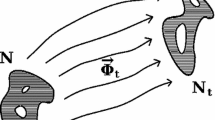Abstract
We discuss an exact solution to the simplest nontrivial example of a geometrical phase in quantum mechanics. By means of this example: (1) we elucidate the fundamental distinction between rays and vectors in describing quantum mechanical states; (2) we show that superposition of quantal states is invalid; only decomposition is allowed—which is adequate for the measurement process. Our example also shows that the origin of singularities in the analog vector potential is to be found in the unavoidable breaking of projective symmetry caused by using the Schrödinger equation.
Similar content being viewed by others
References
M. Berry, “Anticipations of the geometrical phase,”Phys. Today 43, 34–40 (1990); see bottom of p. 34.
E. P. Wigner,Group Theory and Its Application to the Quantum Mechanics of Atomic Spectra (Academic Press, New York, 1959); cf. pp. 47–57 and 325–348.
For a review of this subject, see: A. Shapere and F. Wilczek,Geometric Phases in Physics (Advanced Series in Mathematical Physics, Vol. 9) (World Scientific, Singapore, 1989).
M. Berry, “Quantal phase factors accompanying adiabatic changes”,Proc. R. Soc. London A 392, 45–57 (1984).
L. J. Boya, “State space as projective space,”Found. Phys. 19, 1363 (1989).
L. C. Biedenharn and J. D. Louck,Angular Momentum in Quantum Physics (Encyclopedia of Mathematics and Its Applications, Vol. 8) (Addison-Wesley, Reading, Massachusetts, 1981), p. 459.
W. Greub and H.-R. Petry, “Minimal coupling and complex line bundles,”J. Math. Phys. 16, 1347–1351 (1975).
L. C. Biedenharn and J. D. Louck,The Racah-Wigner Algebra in Quantum Theory (Encyclopedia of Mathematics and Its Applications, Vol. 9) (Addison-Wesley, Reading, Massachusetts, 1981), p. 207.
P. A. M. Dirac, “Quantized Singularities in the Electromagnetic Field,”Proc. R. Soc. London A 133, 60 (1931).
For an introduction to this topic, see: N. Steenrod,The Topology of Fiber Bundles (Princeton Mathematical Series, Vol. 14) (Princeton University Press, Princeton, 1951).
Author information
Authors and Affiliations
Additional information
To Professor Asim O. Barut on the occasion of his 65th birthday.
Rights and permissions
About this article
Cite this article
Solem, J.C., Biedenharn, L.C. Understanding geometrical phases in quantum mechanics: An elementary example. Found Phys 23, 185–195 (1993). https://doi.org/10.1007/BF01883623
Received:
Issue Date:
DOI: https://doi.org/10.1007/BF01883623




